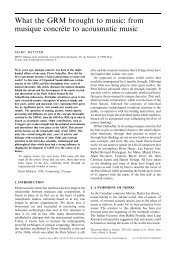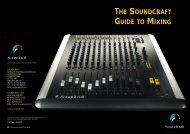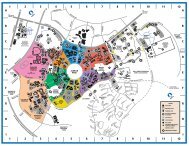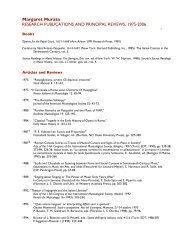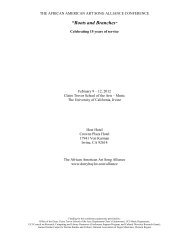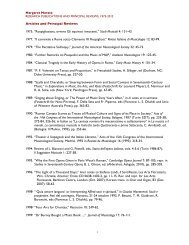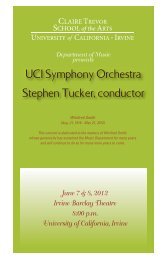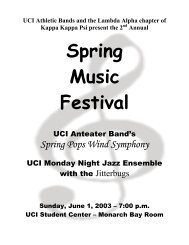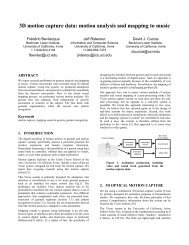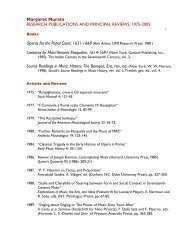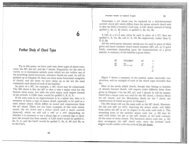amy bauer The Other of the Exotic: Balinese Music as Grammatical ...
amy bauer The Other of the Exotic: Balinese Music as Grammatical ...
amy bauer The Other of the Exotic: Balinese Music as Grammatical ...
Create successful ePaper yourself
Turn your PDF publications into a flip-book with our unique Google optimized e-Paper software.
<strong>The</strong> <strong>O<strong>the</strong>r</strong> <strong>of</strong> <strong>the</strong> <strong>Exotic</strong> 363<br />
Ex. 17 ‘Galamb borong’, transformation network <strong>of</strong> main <strong>the</strong>me (MT) and transition<br />
motive (TR), bars 3–33<br />
5 10 20 25 30<br />
RH<br />
‹<br />
‹<br />
‹<br />
1– 2–<br />
5<br />
MT<br />
T MT T<br />
0<br />
10<br />
T 8 series:<br />
<br />
TR TR<br />
MT<br />
RI 7<br />
I 1<br />
I 7<br />
MT<br />
LH<br />
‹<br />
‹<br />
6–3<br />
I 5 T 3<br />
MT<br />
tail<br />
I 5<br />
MT<br />
tail<br />
MT<br />
T 0<br />
aggregate<br />
T 6<br />
MT<br />
aggregate<br />
series:<br />
<br />
‹<br />
‹<br />
‹<br />
1–2–5<br />
TR<br />
‹<br />
‹<br />
T 4<br />
6–3<br />
TR<br />
R 4<br />
R<br />
T 2<br />
2<br />
TR<br />
‹<br />
‹<br />
4–1<br />
MT<br />
series:<br />
<br />
replicates at T 10 to produce a full six-note ‘series’ in <strong>the</strong> soprano voice. <strong>The</strong> next<br />
full (and indeed <strong>the</strong> final) appearance <strong>of</strong> <strong>the</strong> main <strong>the</strong>me comes at <strong>the</strong> end <strong>of</strong><br />
Section 1 in <strong>the</strong> left hand. Here, in <strong>the</strong> lowest b<strong>as</strong>s and highest treble, it<br />
accompanies itself so <strong>as</strong> to cycle through <strong>the</strong> even-note collection not once, but<br />
twice.<strong>The</strong> transition motive opens up <strong>the</strong> seventh, third and first octaves respectively.<br />
It is transposed outwards and inverted between <strong>the</strong> hands to exchange<br />
ˆ2 with ˆ5 (bars 8–11) and with ˆ3 (bars 14, 26) in turn before terminating <strong>the</strong><br />
motive on ˆ1 in <strong>the</strong> first octave (bar 26), having run through eleven pitch cl<strong>as</strong>ses<br />
en route.<br />
<strong>The</strong> ra<strong>the</strong>r abstract motivic and contrapuntal structure <strong>of</strong> <strong>the</strong> Étude is enlivened<br />
by subtle allusions to tonal practice which include parallel 5 6 chords in bars<br />
12–13, <strong>the</strong> minor seventh chords which harmonise <strong>the</strong> molto cantabile melody at<br />
bars 19–20 and <strong>the</strong> serial melody which begins in <strong>the</strong> right hand and continues<br />
in <strong>the</strong> left (Ex. 18). In addition, ‘Galamb borong’ perv<strong>as</strong>ively inverts <strong>the</strong> harmonic<br />
values <strong>of</strong> tonal music.Whole-tone harmonies prevail, with <strong>the</strong> intervals <strong>of</strong><br />
<strong>the</strong> second, <strong>the</strong> tritone and <strong>the</strong> minor seventh being perceived <strong>as</strong> contextual<br />
consonances (especially when shadowed by <strong>the</strong> minor third that produces,<br />
among o<strong>the</strong>r sonorities, <strong>the</strong> aforementioned inverted seventh chords), while<br />
fifths are marked <strong>as</strong> dissonant. Melodic motion by semitone occurs not <strong>as</strong> a tonal<br />
inflection, but ra<strong>the</strong>r on account <strong>of</strong> <strong>the</strong> inherent limitations <strong>of</strong> <strong>the</strong> performance<br />
medium. <strong>The</strong> sheer physicality <strong>of</strong> <strong>the</strong> boundary pitches C8 and A♭0 implies an<br />
infinite space beyond <strong>the</strong> work, <strong>the</strong>reby disturbing <strong>the</strong> balanced system <strong>of</strong><br />
‘Galamb borong’, which began with circular gestures in <strong>the</strong> middle range <strong>of</strong> <strong>the</strong><br />
piano. Yet <strong>the</strong> sense <strong>of</strong> strain evoked by <strong>the</strong> Étude with respect to its implied<br />
physical container plainly links <strong>the</strong> work to its romantic forebears. <strong>The</strong><br />
<strong>Music</strong> Analysis, 27/ii-iii (2008)<br />
© 2009 <strong>The</strong> Author.<br />
Journal compilation © 2009 Blackwell Publishing Ltd.



